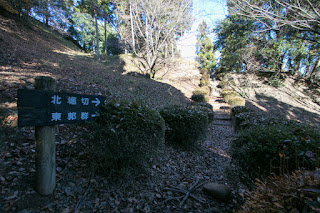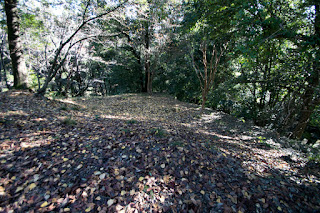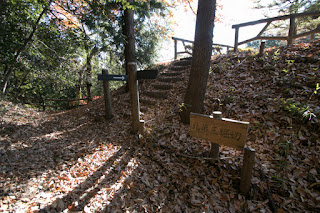Gokan Castle
-Well improved castle park clearly shows its shape-
Overview
Name: Gokan castle (Gokan-jo)
Alias:
Place: Nakagokan Annaka city, Gunma
Type: Mountain Castle
Built: 14th century
Remaining remnants: Clay wall and moats
Title:
Brief History
Gokan castle (後閑城) is built over a hill of about 70 meter height from hillside at the meeting of Tsukumo-gawa river and its tributary Gokan-gawa river, which forms west part corridor of current Gunma prefecture toward Usui-toge pass along with Usui-gawa river and Kabura-gawa river. It is only 3 kilometer apart from Matsuida castle, a large medieval fortress of the area.
Tsukumo-gawa river which runs southward then turn eastward in front of long ridge continues from Usui-toge pass, and castle site exists near this turning point. It is convenient to grasp the flat areas around Tsukumo-gawa river area, and also worked as a side fortress of Tozando main route, which run along Usui-gawa river from Usui-toge pass.
Origin of Gokan castle
The origin of Gokan castle is not clear but it is said to be built in the middle of 15th century by local lord Yoda clan. Yoda clan was originally a local lord of Chiisagata area in the east part of Shinano province (Nagano prefecture), at the opposite of Usui-toge pass. One of their branch family came across the pass and became a local lord, then became a retainer of Nagano clan which was a strong local lord of Minowa castle (Gunma prefecture).
But Yoda clan of this area lost their power in the middle of 16th century, and Gokan clan captured this castle. Gokan clan is said as a descendant of Nitta clan which was famous for Yoshisada Nitta (1301-1338), who contributed to the fall of Kamakura Shogunate in 1333 and fought against Muromachi Shogunate as the South Court army.
A branch family of Nitta clan survived at this place and became a small local lord of Nyu castle at several kilometers southward from Gokan castle. At the invasion of Shingen Takeda (1521-1573), the warlord of Kai province (Yamanashi prefecture) into Kozuke province (Gunma prefecture), Nitta clan belonged to Shingen and might fought against Nagano clan and Yoda clan.
History of Gokan clan
In 1566, Shingen ruined Nagano clan and captured western part of Kozuke province including Minowa castle and Gokan castle. Nyu castle was given to Obata clan which was the local lord of Kunimine castle (Gunma prefecture) and contributed to the victory of Shingen, Nitta clan was moved northward and became the lord of Gokan castle. This time Nitta clan changed their surname to Gokan clan.
Since then, Gokan clan worked as a retainer of Takeda clan. In 1567, at the time of the revolt of Yoshinobu Takeda (1538-1567), Nobusumi Gokan (?-1569?), the leader of Gokan clan, wrote a document swearing the loyalty to Shingen now exists at Ikushima Tarushima Shrine. But it is said that Nobusumi died at the battle against Imagawa clan in 1569.
Gokan clan also served to Katsuyori Takeda (1546-1582), the successor of Shingen Takeda. But in 1582, Takeda clan was ruined by central ruler Nobunaga Oda (1534-1582), and Kozuke province was given to his general Kazumasu Takigawa (1525-1586).
However, just after that Nobunaga died in the incident of Honnoji, and Kazumasu who lost the support of his master was driven by Hojo clan, the warlord of Sagami province (Kanagawa prefecture) and aimed at the unification of Kanto plain. At this time people of Gokan clan belonged to Hojo clan, and served to military duties ordered by Hojo clan. Gokan castle also might be thought as a outer fort of Matsuida castle, an important border castle of Hojo clan.
Structure of Gokan castle
Gokan castle is built over a hill consist of its peak and four ridges spreads four directions like a cross. Central area of the castle is a rectangular shaped one of 50 meter long and 10 meter wide, being surrounded by sheer slope. The root of north ridge and south ridge are divided by deep dry moat.
The western ridge is a broad one and used as a main body of the castle. This ridge is shaped into the layer of three large terraces those size area about 50 meter long and 30 meter wide. These terraces have beautifully curved edge affected by original terrain, but there is no clear ruin of gate at the main route toward central area.
Remaining three ridges are narrow then separated into small terraces for defense. But as southern ridge has a good scenery and might be a battle front, this area might be used as a commanding place with watchtower and securely protected by corridor area. Total size of the castle is about 400 meter long and 200 meter wide, and considerably large one at this area.
Afterward of castle
In 1590, next central ruler Hideyoshi Toyotomi (1537-1598) started Odawara campaign against Hojo clan, for the unity of Japan. Detached army of Hideyoshi crossed Usui-toge pass and encircled Matsuida castle, and Hojo army well kept Matsuida castle for two weeks but finally opened it in April.
At this time leaders of Gokan clan besieged at Odawara castle (Kanagawa prefecture), the main base of Hojo clan. Thus Gokan castle might be substantially vacant and fall at this time. In July Odawara castle also opened to Hideyoshi, and Gokan clan ended its history as a lord along with Hojo clan.
Now all building was lost but structure of the castle well remain on the mountain. Castle hill became Gokan Castle Ruin park, and are well maintained then visitors can easily grasp the shape of medieval castle without woods and weeds. It is also enjoyable such as scenery of mountains such as Mt. Asama or Mt. Myogi, cherry blossoms at spring or red leafs in autumn, thus this site fits both of historic lovers and ordinary visitors.
Access
20 minutes drive from Joshinetsu Jidoshado Expressway Matsuida-Myogi interchange.
Related Castles
Matsuida Castle -Surrender and betrayal-
Minowa Castle -Regional hub castle modified by each holder-
Odawara Castle -Castle rejected attack of two famous warlords-

































































































































No comments:
Post a Comment